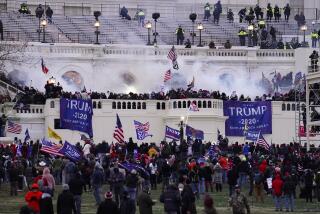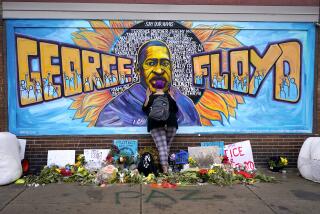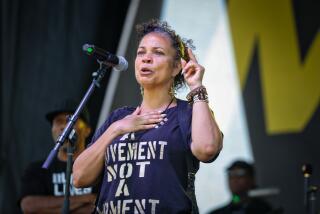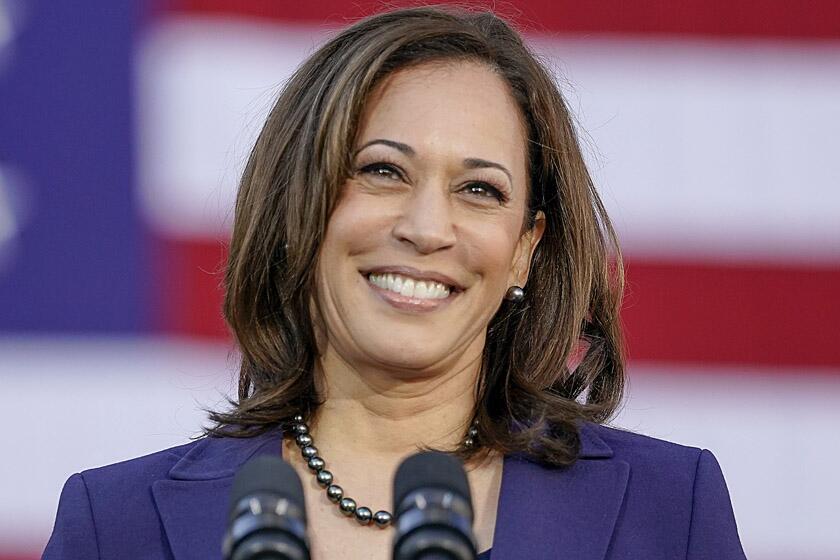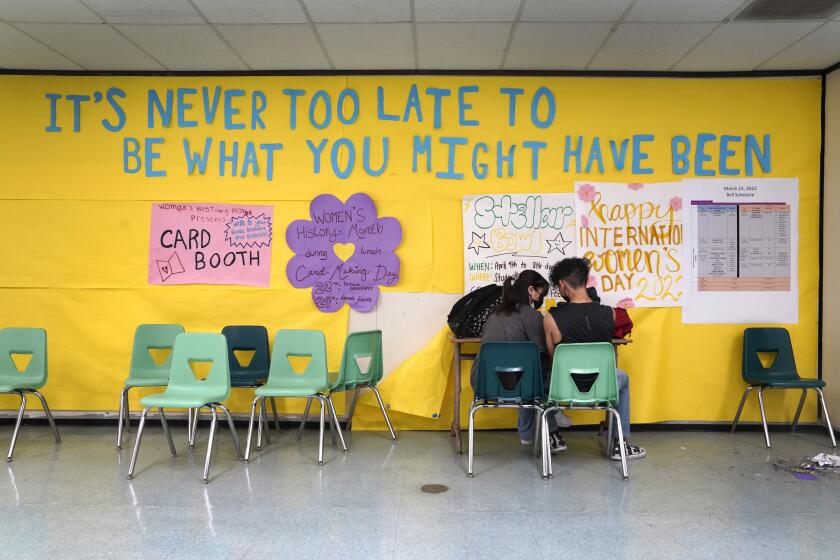Pepper-sprayed at the White House: “It was the worst feeling in the world”
Her mother’s phone number has faded from her arm. Imani Williams wrote it there in black Sharpie on June 1, before heading to the White House to protest George Floyd’s killing.
Her eyes are no longer swollen from the pepper spray law enforcement agents used on the largely peaceful crowd.
But the deep bruise on her left hip had not gone away more than a week later. It’s where the 22-year-old from Fresno was struck by a nonlethal round fired by officers in riot gear who were clearing the way for President Trump to walk to St. John’s Episcopal Church so he could be photographed holding a Bible and looking stern.
In the aftermath of the Washington, D.C., protest, Trump and his staff denied that authorities used tear gas to drive the crowd out of Lafayette Park.
“No tear gas was used, and no rubber bullets were used,” White House press secretary Kayleigh McEnany told reporters two days later.
“FAKE NEWS!” the president tweeted.
Williams wants you to know what happened on that day. She wants you to know about the clouds of gas, the sting of the baton, the thud of the rubber bullet against her body, how fast her heart beat as police horses bore down.
And she doesn’t want the world to forget that the president advocated using force against his own citizens as they demonstrated against racism and police brutality in the nation’s capital.
With each passing day, that second wish, at least, seems closer to coming true.
On Thursday, Army Gen. Mark A. Milley, chairman of the Joint Chiefs of Staff, said he was wrong to have joined the president on his controversial walk through Lafayette Square and that his presence in uniform undermined “the principle of an apolitical military.”
Just hours later, three women who protested June 1 at the White House filed suit in federal court against the president and his administration, alleging that law enforcement action to disperse the protesters violated their constitutional rights.
“Our president has made it scary for me to be Black in this country,” plaintiff Radiya Buchanan, 27, said in an interview, “to be a Muslim in this country, to be a woman in this country, a sister to Black men, a daughter to a Black man.”
A day earlier, more than 1,250 alumni of the U.S. Department of Justice wrote a letter decrying Atty. Gen. William Barr’s “possible role” in ordering the protest to be suppressed. Federal authorities in riot gear, they wrote, “reportedly fired rubber bullets, chemical gas, smoke canisters and stun grenades at peaceful protesters, and otherwise used excessive force, physically injuring many people.”
Those included Williams, who came to Washington from California’s conservative heartland to attend Howard University. Today, she’s a barista, a bartender and a poet, out of work since March, when the novel coronavirus shut the country down.
“I went out Monday, not just for me and my family, but for everyone who could not go out because of COVID,” she said. “To stay on Instagram all day and repost things I agree with, that wasn’t enough.”
Williams learned about racism in her hometown as the child of a Black father and white mother. And she learned about activism at her mother’s knee; Stacy Williams is a longtime Fresno community organizer who was involved in protests after video of a white high school cheerleader in blackface went viral in 2019.
Asked about growing up in the heart of the Central Valley, Williams laughed.
“Oh, Fresno,” she sighed, then told a story about going to the grocery store when she was 8 with her mother and two brothers, who were 5 and 10. The family had moved to Fresno from nearby Merced a year earlier.
Her mother, she said, had always taught them to behave, not to touch anything on the shelves, to stay close, hold on to the cart. On that day, 15 years ago, they were walking down a grocery aisle when an older white woman approached them.
She “stopped and looked at us. All she said was, ‘Ugh, this is disgusting.’ She walked away,” Williams recounted. “Me and my brothers were very confused. I looked at my mom and said, ‘What happened?’ She said, ‘She was jealous that you are beautiful.’
“My mom raised me to be a Black woman,” Williams said. “I didn’t know I was mixed race until Fresno. We were the only Black people in that grocery store, a Vons. It was always the little things, in the grocery store or even at school, being the only Black person in class. … I’m the only Black barista in my coffee shop.”
Williams is named for the seventh principle of Kwanzaa, faith. She still lives near Howard University. On June 1, she grabbed her camera and backpack and headed to the White House at about 1:30 p.m. The protest was calm and peaceful, she said. There were kids and dogs, prayers and chanting.
At around 6:30 or so, she said, the law enforcement presence grew. She saw a row of police officers on horses. Behind them was a row of officers in riot gear, the “pepper spray and rubber bullet shooters.” A flash bomb went off, then another. After the third, she said, “they charged us.”
“I tried to go to my right, away from the horses,” Williams said. “That’s when I got hit on my left side with a baton, on my chest. … I yelled ‘Don’t touch me!’ That’s when two pepper-spray bullets hit my left eye. I screamed, ‘I got hit.’ I was trying to run into the crowd to get help.”
Other protesters offered first aid. Some had jugs of milk and spray bottles of baking soda and water to wash chemicals out of burning eyes. As Williams turned, holding her left eye, she said, she got shot with what she described as two rubber bullets and another pepper-spray projectile.
“It was the worst feeling in the world,” she said. “I honestly didn’t think I was going to see after that. Someone said, ‘Get down on your knees. We’re going to wash you up.’”
It took almost half an hour to rinse Williams’ eyes, she said, in part because they had to keep moving as law enforcement agents swarmed.
She had run into a friend, a 30-year-old photographer and security guard named Kay Brandon, as the melee progressed. She handed him her phone and camera. She showed him her arm where she’d written her mother’s phone number. She asked him to call home for her.
Brandon had just returned that afternoon from Minneapolis, where Floyd died with a white police officer’s knee on his neck, the epicenter of the national unrest. Brandon had documented the protests and their aftermath, the burned buildings, smoke and heat still rising from the rubble. And there he was, in the middle of it again.
“Straight chaos” is how he described the capital that afternoon, “tear gas everywhere,” protesters shot with rubber bullets.
Williams, he said, “was visibly shaken. She was going through it. She had a white powder substance on her clothing where the impact of the tear gas hit her. Her left eye was swollen. She was having an anxiety attack.”
But as Brandon and another protester helped calm the injured woman, the volume of screams around them rose. He grabbed his camera and said, “We gotta go.” The National Guard began clearing them away, he said, “for the president to take a picture. It was all chaos.”
When Stacy Williams’ fear for her daughter wore off, anger quickly replaced it. She’d seen video of the protest, footage of her daughter’s eyes being washed clean of pepper spray, photos of the perfect red circle on her daughter’s hip from the impact of a rubber bullet.
And then she heard the administration’s early response to law enforcement behavior at the president’s front door.
“I see her wounds. Someone called me and said, ‘I have your daughter, but she’s been hit, and we’re washing out her eyes,’” Stacy Williams said in an interview. “You go through all that, and then you see the president and press secretary say nothing like that happened.
“It’s infuriating. The truth has to be told.”
More to Read
Start your day right
Sign up for Essential California for news, features and recommendations from the L.A. Times and beyond in your inbox six days a week.
You may occasionally receive promotional content from the Los Angeles Times.
